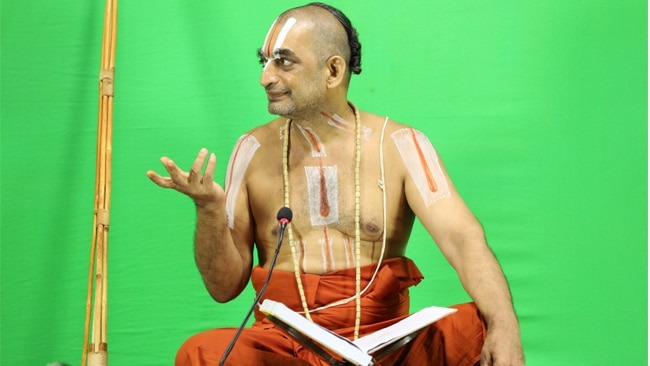This was the expression on every face at the end of ‘Thiruva:imozhi’ class by Swamiji at JIVA Asram today. Why? The richness of content, the flow and choice of words that outpoured from Swamiji came out as a box full of treasure that made everyone speechless while some had tears of joy! Imagine the experience of the writer (Nammalwar) who was once devastated with the separation from God and traverses through a beautiful journey that reunited with Him forever.
Wait a minute, Isn’t God always within us and everywhere? If so, why was Nammalwar feeling separated? Let’s recollect from previous Bhagavad Vishayam sessions here!
Here’s a brief excerpt of the Bhagavad Vishayam class for all our dear readers!
The term ‘Saranagathi’ [act of surrendering or submitting ourselves to God out of devotion] carries huge importance in our scriptures. In fact, Dwaya mantra, Thiruva:imozhi and Ramayan, all these three critical scriptures reflect ‘Dheerga Saranagathi’ (act of complete and continued submission in love for God) as their essence.
Thiruva:imozhi composed by Nammalwar has 1102 pasurams (Dravidian term for poems).Unless we get Vihanga veekshanam, a bird’s eye view of the entire Thiruva:imozhi, it’s not easy to get an overall picture of the scripture.
 Example: Walking in the streets of a town can get you lost if you start off without a map. So, this bird’s eye view of Thiruva:imozhi (map) will keep us intact as we move along.
Example: Walking in the streets of a town can get you lost if you start off without a map. So, this bird’s eye view of Thiruva:imozhi (map) will keep us intact as we move along.
There are 10 hundreds (1000) + 1 closure poem for each ten (100) + 2 additional poems making the total 1102 pasurams. For each of these 10 hundreds (including the closure plus the extra pasuram where applicable), below is the summary. The summary shows at various steps how Nammalwar submits himself to God.
The Bird’s View of Thiruva:imozhi |
|
|---|---|
| First Hundred | An aspirant feels something is missing, and realises that he is incomplete without God. He aims to serve God (Bhagavad Kainkaryam) uninterruptedly and it becomes his only purpose / goal. |
| Second Hundred | He prays that all the blockers in his path (these blockers aren’t from outside, they are all from within ourselves) be removed by the grace of God. |
| Third Hundred | He imagines what it would be like when the blockers are removed. When this happens, the aspirant’s desire to serve God expands and includes all devotees into the horizon. But, he is still waiting for that state. |
| Fourth Hundred | The aspirant now ponders about why there should be blockers on such an ultimate path, the path to God.
These come in two forms: first one is aishwaryam and second one is kaivalyam. Aiswaryam refers to the wealth (of any kind) that one may fall prey to and feel happy about possessing it.This dilutes the ultimate goal – the joy of serving God alone! (When one feels happy about something that he doesn’t connect with God, he will at some point feel unhappy because the object is never permanent) Kaivalyam refers to serving God for the happiness of one-self. Here, the aspirant is not really looking for what makes God happy, but thinks of serving God in the way that makes him/her happy |
| Fifth Hundred | Aspirant tries to remove these hurdles/blockers by himself. He then realises that it is impossible, and God alone is capable to remove them from roots. |
| Sixth Hundred | He now surrenders to God again to help him get rid of these blockers |
| Seventh Hundred | How does he surrender? He takes help of Lakshmi Devi (an embodiment of love) who can recommend the aspirant to Narayana (God – all powerful).
He realises that even after surrendering to Lakshmi Narayana, the bad qualities and the blockers exist in the form of karma and are prohibiting him from attaining the goal. |
| Eighth Hundred |
There is nothing that God cannot do. He therefore questions himself, “why is this karma still haunting me?” The aspirant realises that it is not God’s fault. But, it is only his mistake. He takes examples of incidents from lives of Sri Suka and Prahlada. The situations in their lives seem difficult for us. But, they both never felt or saw them as karma because they didn’t feel attached to them. They received every situation as God own will and, so they were constantly in the mode of serving Him in all situations. The aspirant now declares to God that he doesn’t have any attachment to himself or to the things that he thought belonged to himself. |
| Ninth Hundred |
God now expresses that He is ready to answer his prayers, grant him with what the aspirant had originally asked for – an uninterrupted service. The aspirant feels extremely thankful and submissive to God. He experiences God’s sowseelyam – the quality of being accessible to everyone, no matter how ineligible or incapable one might be! |
| Tenth Hundred |
God now takes the aspirant through the archiradi margam, the White path and sets him free from karmic bondage. Here, the aspirant has no blockers. He is uninterruptedly serving God’s will. His wishes now completely align with God’s will. He doesn’t see or feel himself separate from God. He feels constantly connected, attached to God no matter what task he takes up and wherever he is – including in this world! |
The first phase (First Hundred) talks about being a true aspirant to begin with. Are you in this first phase? If so… the path is clear, march ahead! 😊
If you are not aspirant of serving God, please save this for later! Because, at some point in life if not today – we will question ourselves, is this all there is? Am I missing something? That is when this can be a beginning to a beautiful journey!

The journey is as beautiful as the destination because no matter what phase you are in, you will feel God’s presence throughout! That is why, the getting into the first step which is: ‘aspiration’ is the most important step!
From the teachings of Sri Chinna Jeeyar Swamiji
Bhagavad Vishayam class, 19th July 2019


